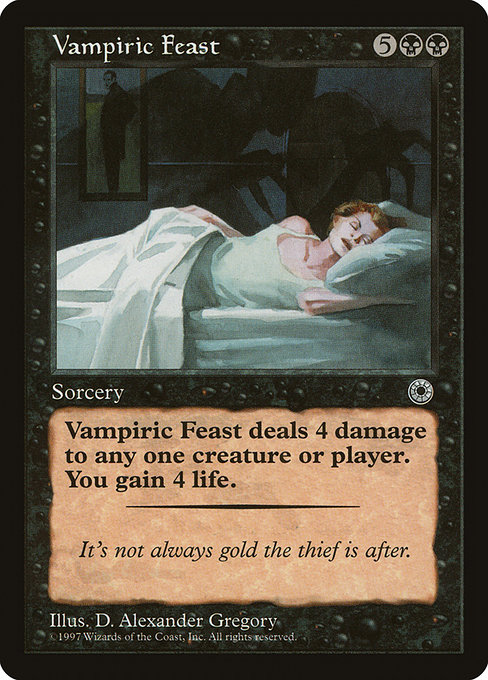
Image courtesy of Scryfall.com
Set Themes Drive Vampiric Feast’s Mechanics
In the grand tapestry of Magic: The Gathering, card design often dances between story and strategy. Vampiric Feast, a Portal-era sorcery, is a shining example of how a set’s overarching theme can steer a card’s mechanics in a way that feels both thematic and tactical. With a mana cost of {5}{B}{B} and a uncommon slot in Portal’s starter-powered lineup, this black spell asks you to weigh a hefty commitment against a potent payoff: 4 damage to any target, balanced by 4 life gained for you. 🧙🔥 It’s the kind of spell that screams “set theme in action” while still inviting a thoughtful, stand-alone duel on the battlefield. 💎
Portal’s design philosophy: approachable power with a dark wink
The Portal set, released in 1997 as a gateway for newcomers to MTG, is built around clarity and accessibility. Its cards tend to favor big, straightforward effects that demonstrate key game concepts without drowning players in complexity. Vampiric Feast fits that mold: it delivers an immediate, unmistakable impact—damage plus lifegain—without requiring fragile timing or fragile combos. The flavor text—“It’s not always gold the thief is after.”—pulls the theme tight, pairing the allure of wealth with the classic vampire’s thirst, a balance of temptation and consequence that mirrors the black-aligned path on the battlefield. 🎨
From a mechanical standpoint, the card’s color identity is purely black, which in MTG lore has long toyed with life totals, resource denial, and dramatic swing spells. Vampiric Feast uses that identity to create a clean, memorable moment: you spend seven mana across the color spectrum’s identity to deliver a decisive event. The spell’s scope—“4 damage to any target and you gain 4 life”—demonstrates black’s duality: the ability to push advantage while cushioning your life total, a classic drain-and-bloom motif that Portal era players could grasp without needing the latest set’s complex interactions. 🧙♂️⚔️
How set themes shape mechanic choices
- Accessible mana curve: With seven total mana on a single spell, Vampiric Feast teaches players to plan their turns ahead, and to appreciate the impact of a well-timed big spell in a game of simplified, introductory rules. The Portal era prioritized teachable moments, and this card delivers one in spades. 🧪
- Directness over duration: The feast doesn’t create ongoing tokens or layering a complex combo; it lands a punch and a lifeline in a single resolution. That aligns with Portal’s ethos of clarity—new players feel the gravity of a high-impact effect without wading through multi-turn setups. 🎲
- Flavorful tension: The lifegain/damage pairing echoes the vampiric motif, where life is both currency and consequence. The flavor line reinforces the theme while offering a narrative hook that players can latch onto during casual matches or in-depth lore chats. ⚔️
“It’s not always gold the thief is after.” — Portal’s flavor, a wink at the darker corners of intrigue and appetite.
Even though Vampiric Feast isn’t a modern Standard staple, its presence in the Portal set—along with its uncommon rarity and black mana identity—serves as a perfect microcosm for how designers balance power with accessibility. The card is legal in Vintage and Commander formats, a reminder that Portal’s legacy lives on in casual play where legacy power levels aren’t gated by the latest card pool. This occasional lineage makes it a charming centerpiece for collectors and players who savor both historical context and practical, table-ready value. For folks building a nostalgia-forward casual cube or a retro-inspired Commander deck, Vampiric Feast stands as a bold, mood-setting choice. 🧙♀️💎
Art, lore, and the collector’s eye
The art by D. Alexander Gregory captures a moment of dark grandeur, with shadows lengthening around the spell’s ominous promise. The Portal set—being a starter line—leans into iconic, memorable imagery rather than experimental design, making Vampiric Feast a familiar, collectible piece for players who enjoy engaging with MTG’s visual language. Its border is black, typical of the era, and its full art presence is understated by today’s standards, which some collectors especially appreciate for its classic vibe. When you pair a card’s flavor with a clear, teachable mechanic, you end up with a card that’s not just playable, but story-ready. 🧲
From a meta perspective, the card’s straightforward effect makes it a good teaching tool for new players—showing how life totals, removal, and targeted damage can interact in a single, decisive moment. The black-aligned theme of sacrifice or payoff reappears across many MTG blocks, and Vampiric Feast stands as a historical touchstone that demonstrates how a set’s overarching themes can concretely shape individual card design. 🎨
Beyond the spell: set themes shaping future design
When we look back at Portal and Vampiric Feast, it’s clear how early set themes seeded a design language still felt in modern print runs. Today’s designers still weigh how a card’s cost, color identity, and immediate impact will teach players fundamental tactics—while still delivering a memorable moment that resonates with the story being told on the card. The lifecycle of a card like Vampiric Feast—from classroom staple in Portal to cherished nostalgia piece in Vintage and Commander communities—shows how a single mechanical choice can echo across decades. 🧙♂️💫
If you’re the type who loves mixing your MTG hobby with practical, everyday gear, you’ll appreciate cross-promotions that keep the fandom lively between games. And since a solid table setup can feel as legendary as a well-timed spell, consider grabbing gear that keeps your grip steady and your phone within reach—like the handy Phone Click-On Grip: Reusable Adhesive Phone Holder Kickstand. It’s the kind of small, useful upgrade that makes long nights of drafting or late-night cube sessions feel a little smoother. Click below to explore.